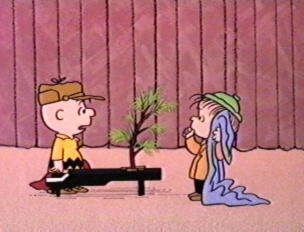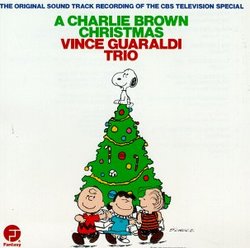Charlie Brown Jazz III
Forty years ago today, television audiences first laid eyes on A Charlie Brown Christmas, the first Peanuts special. Since then it has aired annually every December and had an enduring presence in the culture surrounding the Christmas season. It is widely regarded as not only one of the greatest Christmas specials put to film, but as a testament to the true meaning of Christmas.
Yet network executives were skeptical of the special for four reasons: They did not follow jokes with a laugh track. Children were used to act out the roles, some of them so young they couldn’t yet read the script. There were explicit references to the Bible and the Nativity. And the usual bustling but colorless cartoon soundtracks of the time were absent in favor of a subtle and nuanced jazz track. They were convinced the special would be a total flop.
Of course they were wrong, as network executives frequently are when determining what good entertainment is. The creative choices that worried the executives turned out to be the most effective creative choices made in the production, and we are all fortunate that Schulz, along with his collaborators Lee Mendelson and Bill Melendez, fought so diligently for creative control.

The religious themes are profound and I believe that we are all fortunate that at least once every holiday season Linus steps out to center stage to explain the true meaning of Christmas:
And there were in the same country shepherds abiding in the field, keeping watch over their flock by night.
And, lo, the angel of the Lord came upon them, and the glory of the Lord shone round about them: and they were sore afraid.
And the angel said unto them, Fear not: for, behold, I bring you good tidings of great joy, which shall be to all people.
For unto you is born this day in the city of David a Savior, which is Christ the Lord.
And this shall be a sign unto you; Ye shall find the babe wrapped in swaddling clothes, lying in a manger.
And suddenly there was with the angel a multitude of the heavenly host praising God, and saying,
Glory to God in the highest, and on earth peace, good will toward men.
Of course the jazz track referred to by the executives is now a best-selling Christmas album, and several tunes are celebrated as holiday classics and jazz standards.

Of the enormous amount of music composed and reinterpreted throughout his run on the Peanuts specials, only three CDs were released while Guaraldi was alive. A Charlie Brown Christmas in many ways served as a companion to A Boy Named Charlie Brown as the character themes used were virtually identical. The addition of Guaraldi’s arrangements of classic Christmas carols helped make the special more accessible by adding familiar musical themes while also exploring Schulz’s literary themes regarding the true meaning of Christmas.
The centerpiece of the album is Christmas Time is Here, an original Guaraldi tune that is as easily recognized as some of the most enduring Christmas carols. As with Happiness Is on his previous album, Guaraldi doesn’t play happiness and joy, he ruminates on them, just like Charlie Brown.
“Do they still make wooden Christmas trees?” The innocent question sums up the commercialization Charlie Brown saw in Christmas. The scene where Linus and Charlie Brown go off looking for a Christmas Tree is complemented nicely by O Tannanbaum, a very formal playing of the classic for the first 16 measures or so, and then a little jazzier, and a little jazzier, until it’s virtually unrecognizable. Commercializing Christmas just adds a twist here and a twist there until you forget what you’re celebrating.
One track for the special was actually left off the album, a ritzy swing riff that played while Snoopy decorated his doghouse in order to win a decorating contest. It was the perfect music for the situation, and just stood out as an example of jazz that fit, but was not recognizably Christmas music. The track turned up later on the collection Charlie Brown’s Holiday Hits under the title Surfin’ Snoopy.
It was A Charlie Brown Christmas that cemented the style of the artistic collaboration between Guaraldi, Melendez, and Schulz. I’m not sure if there’s such a thing as “jazz animation,” but the distorted figures of the Charlie Brown characters could begin to define such a term. As Charlie Brown found his footing in the animated world, certain things had to be very different from the strip. Backgrounds are used sparingly in the strip as it was originally conceived as a space-saver feature, that each panel could be represented in a space the size of a postage stamp. The show’s script required placing the characters outside of their normal contexts: walking through town, buying a Christmas tree, and up to 10 characters dancing on stage. Given the extra room allowed by television animation the characters were placed on a landscape of distorted perspective, monotone houses, and an absolutely enormous stage.
(Another argument for the Peanuts specials as “jazz animation” is a creative innovation in the use of musical instruments. The voices of adults are the work of a muted trombone.)
One astonishing example of great musical work that was never released onto record is the soundtrack for the Halloween special, It’s the Great Pumpkin, Charlie Brown. A wind section was added to the regular trio and flutes were used to great effect on the first version of The Great Pumpkin Waltz and on similar arrangements for Linus and Lucy as well as Charlie Brown’s theme.
The Linus and Lucy arrangement was particularly effective in the opening scene of the special, where Linus and Lucy take a walk to find a Jack O’Lantern. The flutes respond playfully to the hard piano rhythm, flitting around like the fallen leaves Linus kicks on their walk. The flutes were used to just that effect in the very next scene, when their musical responses are to Snoopy blowing a falling leaf into the air again and again, until it lands on top of a large pile of leaves Charlie Brown is raking before it ever touches the ground.
The Great Pumpkin Waltz perfectly captures the naive uncertainty of Linus, chasing the Great Pumpkin in tireless devotion, alone, determined, but ultimately unsure. He stubbornly insists on clinging to a notion his friends assure him is absurd to avoid the embarrassment and shame of admitting once and for all that there is no Great Pumpkin, that the other children’s taunts are justified.
In Peanuts, no desire is ever satisfied. Linus’s fear of being proven wrong becomes over time a delicate dance of clutching youth while a forbidding truth slowly dawns on you, drawing you unwilling and unprepared into a cold world where giant pumpkins do not fly through the air to bring presents to good little boys and girls, no matter how sincere your pumpkin patch is. He is trapped between the three points of the other children, the Great Pumpkin, and his own ego. He writes a letter to the Great Pumpkin and closes it: “P.S. If you really are a fake, don’t tell me. I don’t want to know.”
Finally, Sally abandons him and the shadowy figure in the pumpkin patch turned out to be a World War I Flying Ace, and Linus is left all alone, swearing to his friends that the Great Pumpkin will appear. In the end, he ruins it for himself:
“If the Great Pumpkin comes I’ll be sure to put in a good word for you! Good Grief! I said ‘if‘! I meant when he comes! I’m doomed. One little slip like that can cause the Great Pumpkin to pass you by.”
This is the intense crisis of self that Linus experiences when the Great Pumpkin fails to appear. He must rationalize it somehow before he can face the other children. Lucy still has to drag him, shivering and miserable, back from the pumpkin patch.
The last Peanuts record released while Guaraldi was alive was Oh Good Grief! in 1968. This album added an electric guitar to the band, and consisted of studio sessions of some of the later character themes in the Charlie Brown specials, for characters like Peppermint Patty and Snoopy. There is a version of The Great Pumpkin Waltz, but the use of electric guitar isn’t nearly as effective as their use of woodwinds throughout the special.
In 1998 a sampling of music from the Charlie Brown specials finally saw CD release on the album Charlie Brown’s Holiday Hits. It includes the major musical pieces from the holiday-themed episodes as well as some character themes written later than the existing albums. Some enduring scenes conjured by the music in this collection include Charlie Brown holding an empty Valentine box, Linus throwing chocolates off a small bridge in a jealous fit for Miss Othmar, and Snoopy serving up a fabulous Thanksgiving dinner of popcorn, jelly beans, and toast. It also features Guaraldi’s original version of The Great Pumpkin Waltz.
In 2003, another lost CD of material was released, The Charlie Brown Suite and Other Favorites. The album opens with a big band version of Linus and Lucy, maybe the best version of the song ever recorded. The Charlie Brown Suite itself is a long and ambitious piece that comprises much of the album, incorporating several themes from the strip into a more unified whole.
Apparently studio sessions for the specials themselves are patchwork and hard to come by. But lost Guaraldi material continues to roll out at a slow but steady pace. Most recent release was live footage from a concert Guaraldi recorded with the San Francisco Boy’s Choir which includes a version of Little Drummer Boy and Peppermint Patty. [Both MP3]
I might have covered these later releases in more detail, but unfortunately I don’t have a copy of them yet. Oh, well. Remember Linus when you’re out doing your Christmas shopping this year.